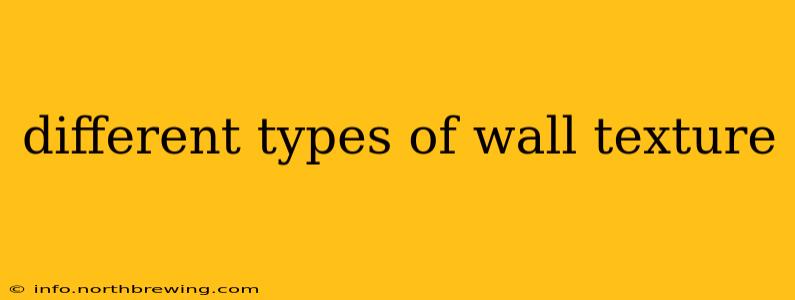Wall texture plays a crucial role in setting the mood and style of a room. From subtle elegance to bold statements, the right texture can transform a space. This comprehensive guide explores the various types of wall textures available, helping you choose the perfect one for your home. We'll delve into the pros and cons of each, addressing common questions to ensure you make an informed decision.
What are the different types of wall textures?
Many options exist for achieving different wall textures, each offering unique aesthetic and practical qualities. These can broadly be categorized into several types:
1. Smooth Textures
Smooth walls are classic and timeless, offering a clean, minimalist look. They’re easy to clean and maintain, making them a popular choice for modern homes and spaces requiring a sleek aesthetic. However, imperfections in the wall are more visible with smooth finishes. Popular methods for achieving a smooth texture include:
- Venetian Plaster: A luxurious, highly polished finish known for its elegance and depth. It's more expensive and requires skilled application.
- Standard Paint: A simple and cost-effective method for achieving a smooth surface. Preparation is key to achieving a truly smooth finish.
- Wallpaper: Certain wallpaper types offer a very smooth finish and can hide minor wall imperfections.
2. Lightly Textured Walls
Lightly textured walls offer a subtle visual interest without being overly dramatic. They can help hide minor imperfections while maintaining a relatively clean look. Popular methods include:
- Orange Peel: A very common, slightly bumpy texture resembling an orange peel. It's durable and easy to clean.
- Popcorn (Acoustic): This heavily textured finish was popular in the past, primarily for its sound-dampening properties. However, it's becoming less common due to concerns about asbestos. Removal is often complex.
- Knockdown: This technique involves applying a thicker layer of texture and then “knocking down” the peaks with a special tool, leaving behind a slightly uneven but visually pleasing surface.
3. Heavily Textured Walls
Heavily textured walls make a bold statement, adding depth and visual interest to a room. They're excellent at disguising imperfections but can be more challenging to clean and maintain. Options include:
- Sand: A rough, grainy texture resembling coarse sand.
- Stucco: A durable exterior finish that can also be used indoors for a rustic or Mediterranean feel. It requires professional application.
- Sgraffito: This artistic technique involves applying multiple layers of plaster in different colors and then scratching away portions to reveal the underlying layers, creating intricate designs.
What is the easiest wall texture to apply?
The easiest wall texture to apply is undoubtedly standard paint applied to a properly prepared surface. Achieving a perfectly smooth finish with paint requires careful preparation, but the application itself is straightforward. Lightly textured options like orange peel are also relatively easy to apply using a hopper gun or spray texture machine, although renting or buying the equipment might be necessary.
What is the most popular wall texture?
The most popular wall texture varies by region and style preferences. However, lightly textured options such as orange peel remain consistently popular due to their balance of durability, ease of application, and pleasing aesthetic. Smooth finishes are also highly popular in modern homes, while heavily textured finishes see more niche use in specific design styles.
How much does it cost to add texture to walls?
The cost of adding texture to walls varies greatly depending on the type of texture, the size of the area, and the labor costs. Simple paint jobs are the most economical, while techniques like Venetian plaster or professional stucco application can be significantly more expensive. Always get multiple quotes from reputable contractors to ensure you get a fair price.
What is the best texture for hiding imperfections?
Heavily textured finishes, such as stucco, sand, or heavily applied knockdown textures, are best at hiding imperfections in walls. These options create depth and visual interest that deflect the eye from minor flaws in the underlying surface.
Which wall texture is best for a bedroom?
The best wall texture for a bedroom depends on personal preference. Smooth finishes create a clean and calming atmosphere, while lightly textured walls offer subtle visual interest without being overwhelming. Heavily textured walls might be too bold for some bedrooms but could work well in a themed or accent wall.
This guide offers a broad overview of the various wall textures available. Remember to consider factors such as your budget, the overall style of your home, and the level of maintenance you're willing to undertake before making your final decision. Consulting with a professional painter or interior designer can provide personalized recommendations and ensure a successful outcome.
